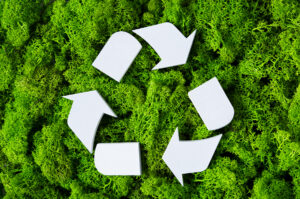HCPA and CMI publish Aerosol Recycling Initiative white paper

Launched in 2022, the initiative’s goals are to achieve by 2030 at least an 85% recycling access rate for all aerosol cans, which means that households have the ability to recycle their empty aerosol cans in their local recycling programmes, and label at least 90% of aerosol cans as recyclable with messaging about how to properly recycle them.
The white paper found that almost 4 billion aerosol containers - made from almost 300,000 tons of steel or aluminium - are sold in the US each year. This can result in a significant amount of packaging material that can end up in landfills if not recycled properly.
The benefits of aerosol recycling
Although questions regarding the accessibility and safety of recycling aerosol products have been raised, when incorporated as part of a broader waste management system, recycling can provide enormous benefits to communities, the economy and the environment.
Increasing recycling reduces the need for raw material extraction by keeping valuable material in circulation, retaining economic value, creating jobs, and reducing greenhouse gas (GHG) emissions, according to the paper.
It added that recycling just one aerosol reduces GHG emissions by the equivalent of driving 0.5 miles in the average petroleum-powered passenger vehicle or charging 13 smartphones.
Looking at a larger scale, a 50% recycling rate of aerosols annually delivers savings equivalent to the energy use of nearly 48,000 US homes per year, or the annual GHG emissions from more than 87,000 petroleum-powered passenger vehicles.
From an economic standpoint, a 50% recycling rate of aerosols generates more than $39 million (€35.9 million) each year. Since metal recycles forever, the benefits compound as the aluminium and steel from these products continues to be recycled.
There is uncertainty about the appropriate end-of-life management of aerosol products, added the paper.
More and more stakeholders are questioning whether a product’s packaging is truly recyclable, leading to questions about recycling rates and what happens to a product after it is put in the recycling bin.
This growing concern coincides with decreased opportunities for end users to recycle aerosol cans.
For example, the national access rate for aerosol products (the percent of Americans with access to recycling programmes that accept aerosols) dropped from 70% in 2016 to just above 60% in 2021.
Initial Aerosol Recycling Initiative focus areas
The Initiative established four focus areas and accompanying activities for the initial phase, with the support of 17 companies across the aerosol value chain.
The first was addressing data gaps. This involved labelling analysis to establish a baseline for current recycling-related messaging on aerosols. It also entailed undertaking environmental and economic impact analysis to evaluate the potential benefits of recycling more aerosols. Another aspect of data procurement involved aerosol can testing to assess the extent to which residual contents remain in aerosols that reach material recovery facilities (MRFs).
The second focus area was increasing the acceptance of aerosol cans at MRFs. This entailed interviews with MRF operators to understand their concerns about accepting and processing aerosols.
Understanding consumer awareness was the third focus area, which constituted an omnibus survey to obtain insights on consumer sentiment and awareness of recycling aerosols.
The fourth was publishing the white paper, explaining the aerosol can’s recycling story.
Current situation
The omnibus survey found that more than half of consumers are either unsure if aerosols can be recycled or think they are not recyclable at all.
The recycling programmes that do not accept aerosol cans are reluctant to accept them mainly due to safety concerns that come from consumers not emptying the leftover product from the can.
However, even with a lack of clear communication about how to dispose of an aerosol, most of these cans have no or minimal leftover product.
The Initiative determined this by pressure testing nearly 900 aerosols from two MRFs, finding that nearly 80% of the tested cans had less than 3% residue.
The aerosol industry believes that recycling programmes and the MRFs that sort recyclables should accept aerosol cans for several reasons.
The first is that MRFs can sort both aluminium and steel aerosol cans with existing equipment.
Secondly, since aerosols are made from metal, they have ready end-markets (buyers) and can be a beneficial source of revenue for MRFs.
Thirdly, research from Factory Mutual Corporation has found that the risks associated with including empty aerosols in the recycling stream are manageable.
The fourth reason is that, although some MRF operators perceive aerosols as a fire risk, it is actually very rare for these products to be identified as the cause of a MRF fire.
Finally, when a recycling programme is silent regarding its acceptance of aerosols, as too many often are, consumers do not know where to empty the leftover product or how to dispose of the can.
The next phase
The Initiative has already identified areas that can help achieve the 2030 goals.
These involve forming the Aerosol Recycling Initiative Labeling Task Force to develop a guide with message options to meet the labelling goal. It also means engaging MRFs, municipalities and retailers to offer aerosol recycling access; and advocating for inclusion of aerosol cans on statewide 'recyclable' lists.
The white paper added that there is work to be done on the labelling goal, with the labelling baseline study finding that only 29% of aerosol cans include messaging about how to appropriately recycle the can - specifically that the can must be empty before disposing of it.
However, the Initiative believes this can be addressed fairly quickly, since brands that sell products in aerosol cans have control over what is on the label.
Regarding access, this will involve a multi-pronged approach. It is important to incentvise MRFs not currently accepting aerosols to shift to acceptance by offering industry-funded communications to the community with directions about how to properly recycle these products.
Another focus will be educating municipalities - MRFs' customers - about the benefits of recycling aerosols to build a network of stakeholders who can advocate for the acceptance of these products in recycling programmes.
In areas where there is no kerbside recycling programme for aerosols, the Initiative will encourage partnerships with retailers that have regular pick-ups of surplus or dented aerosols to provide consumers with a convenient recycling access point.
It will also advocate for aerosols to be included on statewide 'recyclable' lists, especially in states that have passed Extended Producer Responsibility (EPR) programmes for packaging.
EPR laws are designed to shift the costs of managing product packaging at end-of-life from municipalities and consumers to the product manufacturers.
At the time of publication, five states (California, Colorado, Maine, Minnesota and Oregon) have passed such laws.











